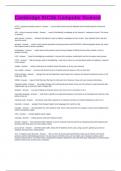Exam (elaborations)
CAMBRIDGE IGCSE COMPUTER SCIENCE EXAMS QUESTIONS AND ANSWERS
- Module
- Institution
Cambridge IGCSE Computer Science HTTP - hypertext transfer protocol - Answer- a set of rules which must be followed when transferring files across the internet URL - uniform resource locator - Answer- used to find/identify a webpage on the internet 1. webserver name 2. file name 3. pr...
[Show more]



